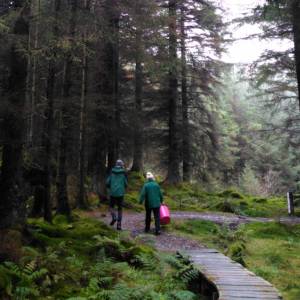LOST in the Great Wood
LOST - an anacronym for ' Looking out for the Small Things'.
If not a Jain plea to refrain from treading on beetles it sounds as if it could be a philosophy for living.
The latter is not so far from the truth.
I went to a LOST workshop today devised by 'Plantlife' for Woodland Managers, to raise awareness of the importance of lichens in our Lakeland Atlantic Temperate rainforests.
Other than observing that some are hairy and some are crusty and that they are generally small I had few other ideas about them. However, it turns out that this grey matter swathing the trees is not only a complex, multispecied, symbiotic community with the ability to withstand extremes of drought and wet but is also fine tuned to indicate the health, or not, of the environment.
There were a few hurdles though to overcome before all this new knowledge could be processed. Lichens don't top the popularity charts for the people-engaging-with-nature movement because there has probably not been so much Latin bandied about since the fall of Ancient Rome. Each wrinkled crisp of a plant has no English name but is blessed with two multisyllabic Latin names such as Platismatia glauca, Usnea subfloridana, Ochrolechia tartarea.
There are about 2000 listed for the British Isles.
Also each part of their varied anatomy has a Latin label and although there are broad colour and shape variations it is not possible see the creases, pimples, lumps and hairs that tell them apart unless you use a hand lens or microscope and concentrate very very hard.
On the other hand when you do manage to get everything in focus they become not only extremely beautiful but fascinatingly varied one from another and in their modes of reproduction.
Looking at lichen with a hand lens gives ample opportunity for the ardent tree hugger to get up close and intimate to bark, share their hair with wood ants, and under instruction, draw a fingernail across Mycoblastus sanguinarius and watch it bleed red or lick the white velvet soredia off a Pertisaria amara. It's a bitter taste explosion and such a fine line between science and creepy!
With the fungal thallus providing the housing that encloses photosynthesising alga and often cyanobacteria that fix nitrogen from the atmosphere, cocktails of chemicals are produced. Some stop UV light for example and scientists are only just beginning to unravel their make up (Although Chanel 5 has used something from Evernia prunastri as a scent fixative for years)
However, it is lichens' ability to receive all their nutrients from the moist atmosphere that make them so able to gauge the cleanliness of air and water and conversely so vulnerable to mass death if exposed to pollution. We are proud of our clean air and water here by Derwentwater but when we looked in Great Wood, we found only one oak out of all, that bore the requisite community of species to prove the point.
So the question for our valley is, 'Is increased traffic and a planned cycle track shoreline development, to cater for World Heritage Tourism, more important than looking out for the small things? Small things that tell us things about the health of our world and ultimately ourselves?
More important than clean air and water?
- 1
- 0

Comments
Sign in or get an account to comment.


